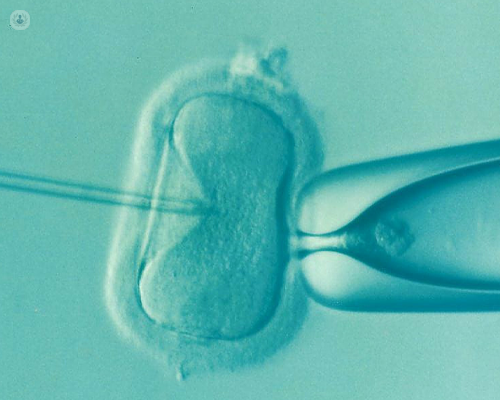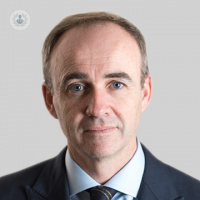Fertility, IVF and the microbiome - Part 3
Escrito por:Fertility is a wide-reaching topic, and each facet is just as important - and interesting - as the other. Whether you’re looking to find out about how to address issues regarding conceiving, the microbiome and its relation to improved fertility or IVF, this four-part series can assist. Furthermore, the ethical and moral issues surrounding genetic ‘editing’ are significant talking points.
Mr Stuart Lavery, consultant gynaecologist and specialist in reproductive medicine and surgery, discusses IVF and egg freezing in expert detail in part three of his fertility series.

Regarding initial intervention, would we be looking at IVF?
Not necessarily. Many couples feel like: ‘We're not getting pregnant; we need to book in for IVF’. Although IVF is an amazing, wonderful treatment that’s very effective, it's not the only thing to consider.
The best option is to have really accurate diagnosis and to try and identify a cause for the fertility and then treat that. For example, if a couple are trying naturally but the woman's periods are irregular and she's not ovulating regularly, but everything else is fine. She doesn't necessarily need to go for IVF. She could just take a medication such as Clomid, which is a tablet. It's been around since 1961. That can be very effective, about 80 per cent effective at giving her very regular periods. And about 50 per cent of pregnancy patients will be pregnant within six months.
You may have to deal with an unexplained scenario, but it's better to ensure you have accurate diagnosis before rushing straight for IVF.
How many rounds of IVF do you should women do before they stop?
That's a really difficult question and has to be individualised. There is a cumulative chance of IVF working, by which I mean, the more goes you have, the greater the chance of it working. It's a bit like trying. Naturally, you wouldn't dream of giving up after one month of trying. Naturally you would just keep going.
After three cycles of IVF, success rates do start to flatten out a little bit, and after five goes, they also begin to flatten out a little bit. It also depends a little on how you respond. For example, if you continue to produce great numbers of eggs with lovely quality embryos, it's probably worthwhile going on a little bit longer.
If, for example, on your first go you only get maybe two eggs or one embryo, then your body might be sending you a message how this may not be the best way forward, and it's unlikely that cumulative attempts at IVF would be successful.
How does IVF work? Is there just one way of doing it? Is it one standard procedure?
The principles of IVF are the same, but there are multiple different ways of doing it. Again, you can personalise these to a woman’s or couples’ situation. The basic IVF principle is that you obtain an egg from a woman, a sperm from a man, and they meet in the laboratory. You can actually confirm that fertilisation.
I sort of facilitate it, but the actual hard work is done by the embryologists in the lab. These are the people that patients never see, and yet when you talk about what are the critical steps or people associated with IVF success, it's these scientists who are the critical in handling these delicate eggs and sperm. They’re making sure they get together in the right environment, and, even more importantly, allowing the embryos to grow for a few days in order to allow us to select which ones that will have the best chance of success.
How many embryos would you grow?
Again, on average, it depends a little bit on the age of the woman. However, if we get, for example, on average, ten eggs, when we put them with sperm, about two thirds will fertilise. We leave those embryos to grow, hopefully for about five days.
That allows us to take Darwinian survival of the strongest view. Once we've got to five days, we hope there are several blastocysts available. A blastocyst is an embryo at the fifth day of development. If you imagine getting pregnant, the egg and sperm naturally meet in the fallopian tube. As that embryo is traveling down to the uterus, it's growing and dividing. It only reaches the uterus on its fifth day of development. In nature, the embryo is at the blastocyst stage when it lands in the uterus and implants.
Nature's showing us the way. What we try and do is, is try and create a natural environment as possible so when that blastocyst lands in the uterus, it has the greatest chance of implanting.
Twins in this country run at about one in 80 pregnancies. They're quite common. Triplets, about one in 6400, are common, too. There are amazing stories of naturally-occurring quads, twins and sextuplets.
How many of the embryos are viable and they're going to be robust? Do you put just one back in? Do you put them all back?
In the vast majority of women, we put one back and it's been a real advance in reproductive medicine, improving the safety of the technique. You may be familiar with headlines, from years gone by, of IVF quads. These are now considered a treatment failure. This is because with the prognosis of a triplet or a quad pregnancy, the risk of miscarriage and premature birth is so high.
One of the recent successes in reproductive medicine has been the encouragement of selecting the one best embryo. And we've been doing that in the UK, now probably for about six or seven years. And we've managed to get the multiple pregnancy rate down to less than 10 per cent. At the same time, we've maintained our success rates. It's been a really big advance in the field that was really led initially by the Scandinavians and the Belgians, but is now traveling around the world.
What happens to the remaining embryos?
We would encourage the couple to freeze the embryos if they're good quality. When you freeze an embryo, you sort of fix it in time. The process is now called vitrification. This is essentially flash freezing by placing the embryo into a bowl of liquid nitrogen. If you can imagine that cells are mostly water, but if you allow them to freeze, that would expand and disrupt and kill the cell. We freeze the embryo so quickly that ice crystals can't form and as a result, the cell membranes will remain intact. If you freeze an embryo at age 30, the embryo will always think that you are 30. Even if you return five, six, seven years later, you will have the success rate of a 30-year-old.
The uterus ages much slower than the ovaries. When it comes to time sensitivity, the uterus can be very robust. We see these stories of women conceiving in their fifties, sixties and seventies. But the eggs will not be 50 or 60 years old. The eggs will be younger.
Is this why there are more younger women who decide that they want to freeze their eggs for the future?
There have been two things that have driven egg freezing. Number one, there's been a demographic change. There are women and sometimes men who feel now is not the right time to get pregnant for whatever reason. There's a variety of different reasons for that.
For example, a person might think: ‘Can I freeze my eggs now? I hope and pray I never need to use them. I do still want to get pregnant the old-fashioned way in years to come, but it some form of reassurance to have these things in the freezer?’ And I think there are more people that are thinking that way.
The science has only just caught up with that demographic movement. I've been freezing eggs for more than 15 years, and we started off doing this in cancer patients who are facing chemotherapy or radiotherapy. But the results were not great; there was about 8 per cent chance of getting pregnant. When women would come to us and say: ‘Look, I don't want to get pregnant now, but I want to freeze my eggs, can I do it?’ We would try and put them off. It's not an insurance policy if you've only got an 8 per cent chance of having a pregnancy.
Now, what's happened is the science has moved on and it's been this science of vitrification, which comes from Japan originally, that’s giving women much more confidence that: ‘If I freeze the eggs now, there is a good chance this is going to help me have a baby later on’. And so that sort of science and demographic move have now come together, and egg freezing is becoming increasingly more popular.
Would you suggest that you can freeze eggs on their own, and then maybe wait for a partner? Or would you, for example, if you were having medication, would it be better to freeze embryos?
In the past, freezing embryos was always better. We would always say if there is a man around or if there's donor sperm around, let's use that, because the success rates were significantly different. What's happening now is that vitrification has got the success rates pretty much the same as embryo freezing. There’s probably about 2 per cent difference, which is probably not meaningful.
Now you can have pretty much the same level of confidence in freezing your eggs as previously you would have had about freezing your embryos. It's still early. We still have hundreds of thousands of frozen embryos giving us babies, but the number of frozen eggs that have led to babies is still relatively small. We're still learning, but the numbers look reassuring and the data looks optimistic.
Is this something that is only available privately?
On the NHS we can do egg freezing for medical reasons. So, if you're facing chemotherapy, radiotherapy or surgery, something that will compromise your future fertility. Most health authorities these days will fund that on the NHS. If you're doing it more for elective freezing social reasons, whatever it might be, it would be very unusual for the NHS to freeze them, and most of those patients end up seeking treatment in the private sector.
Arrange an appointment with Mr Lavery to address any of your IVF and egg freezing queries, via his Top Doctors profile.



